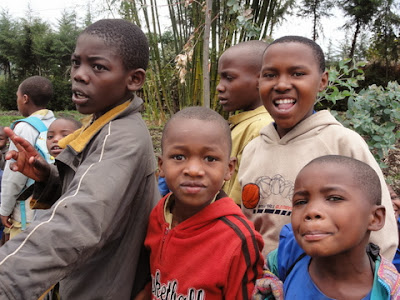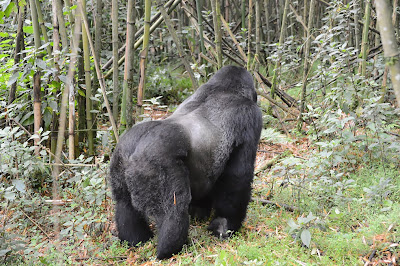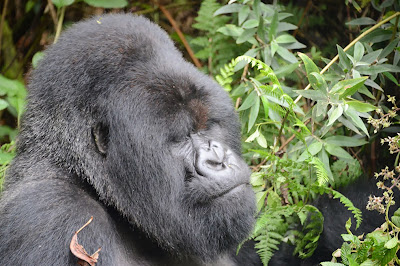More than the Gorillas
From the outset Herbert our guide made it
clear to us that although we had come to Rwanda to see the gorillas he wanted
us to do more than that. Rwanda is a country that has had a troubled past and
is now working very hard and successfully to reestablish itself. I knew from my
previous work with war veterans that many of the Australian peacekeepers that
worked in Rwanda have severe post traumatic stress. I did not know Rwanda’s
history in the detail that Herbert told us and it is some story.
This is as he told it to us and from my
reading since.
Rwanda was first visited by Europeans in
1858. In 1890 it became part of German East Africa under German rule. It was
occupied by Belgian forces in 1916 during WW1. Under the Treaty of Versailles in
1918 Rwanda was made a League of Nation protectorate to be governed by Belgium.
This turned into a form of colonial rule. In 1932 Belgium introduced identity
cards into Rwanda. 15% were made Tutsis and 84% Hutu. The difference between
Tutsi and Hutu historically is unsure. They spoke a common language and
physical differences were difficult to see if any. Herbert told us that those who
owned more than 10 cows were made Tutsi and others Hutus, except for a small
minority of Twa tribe who are Pygmies.
Well to do farmers who had previously considered
themselves Hutus were made Tutsis on their identity cards. The Roman Catholic
Church, who were the primary educators in Rwanda endorsed the identity card
system and developed separate education systems for each group. It was mainly
Tutsis who were educated. The Tutsi developed a lot of influence and held most
positions of power. The Hutus felt as though they were under Tutsi rule.
In the late 1940s a democratically minded
Tutsi King – Rudahigwa abolished the separation of Hutus and Tutsis and redistributed
cattle and land. The Roman Catholic Church supported him in this and promoted
equality. Some Tutsis were resentful of this.
I’ll leave you to study the intricacies of
the politics yourself if interested but by the late 1950s a Hutus emancipation
movement was quite strong and there was a revolution. Many Tutsis were exiled
and tens of thousands of Tutsis were murdered. The Tutsi monarchy was
abolished, democratic elections were held and the Hutus came into power.
Rwanda
became independent in 1962. After this Rwanda became a highly repressive,
centralised state. The economy deteriorated and 700.000 Tutsis left Rwanda.
Some joined the Rwandan Patriotic Front (RPF) in refugee camps in nearby countries. They wanted to
return to Rwanda with equal rights. The RPF was demonised by the Hutu dominated Rwandan press.
In Rwanda a Hutu group of youth militia was formed which reflected the ideal of
Hutu power.
In the late 1980s 6000 members of the RPF
invaded Rwanda in an attempt to gain power and a civil war ensued. Hate for the
Tutsis by the Hutus increased.
In August 1993 a peace accord brokered by
Tanzania with support from western countries was formed – The Arusha Accord.
The moderate Hutu Rwandan President – Juvenal Habyarimana signed the Accord which
gave the RPF a part in a coalition government. The extremist Hutu party –
Coalition for the Defence of the Republic refused to sign the accord. The
United Nations sent peacekeepers to assist in the ceasefire but in much smaller
numbers than was considered effective.
The catalyst for the genocide commencing
was on April 6th 1994 when a plane carrying the Rwandan President
and the Burundi President was shot down as it landed in Kagali killing all on
board. It has never been proven who shot down the plane although many suspect
it was extremist Hutus.
Many moderate Hutus, including the Prime
Minister were executed and the Rwandan Military took over the country. The UN
force tried unsuccessfully to resist the military and several of them were also
killed. In the next 100 days an estimated 800.000 – 1 million people were
killed in Rwanda. It was mainly Tutsis who were massacred but also moderate Hutus. Hutu
civilians were incited to kill Tutsis or be killed themselves. Roadblocks were
installed and civilians were unable to flee. Some Tutsis sought refuge in
Churches and school buildings.
In one case 1500 Tutsis sheltered in a RC
Church. With the support of the local priest the Church was bull-dozed and all
were killed. The Priest was later convicted of genocide. In other cases church
officials made valiant attempts to save their parishioners and sometimes
succeeded.
The United Nations assistance was hampered
by members of the UN Security Council not wanting to get involved and refusing to label it as genocide. The Clinton
administration was one of these. Clinton later apologised for this and has said
it’s one of the biggest regrets of his Presidency. The UN were informed by some
brave individuals as to what was going on but thought the reports were
exaggerated. Belgian Peacekeepers withdrew after the massacre of their peacekeepers
early on. This caused the massacre of 2000 people whom they had been protecting
in a school. The peacekeepers who remained were told not to interfere unless
they were personally threatened. A dreadful situation for them where they felt hopeless and observed dreadful sights. In mid May 1994 the UN agreed to send 5.500
troops into Rwanda – the number that had been requested beforehand. Military
vehicles were also sent. Deployment was delayed but arrived eventually.
The genocide was stopped when the Rwandan Patriotic Front (RPF) launched an offensive and took over Kigali on July 4th - 100 days after the genocide started. In anticipation of reprisals approximately 2 million Hutus fled to
refugee camps in neighbouring countries. Many died of cholera and dysentery.
Uo to 500.000 Rwandan women were raped and
now suffer from AIDS, and other sexually transmitted diseases. Many of them
were rendered unsuitable for marriage and have had unwanted children.
When the RPF took over they organised a coalition government
similar to the Arusha Accord. The military party responsible for inciting the genocide was outlawed.
Today the government prohibits
discrimination on the basis of
ethnicity, race or religion. It also prohibits emphasis on Hutu or Tutsi
identity in most political activities.
Over a million Hutu refugees from
neighbouring countries were eventually repatriated to Rwanda because the
countries couldn’t support them.
Because of the collapse of the justice
system during the genocide the court system was painfully slow in the trials of
the Hutus who had participated in the genocide. The government reintroduced an
old court system – Gacaca or social justice which had traditionally dealt with conflicts within
communities. It was adapted to deal with genocide crimes. Local elders were
elected by the public as judges and given some training. It is estimated that
they dealt with over 1 million cases.
Those charged were brought to the courts in
their area. They were told to speak the truth about what they did, identify
others responsible and give testimony and ask for forgiveness. This was done
with the community members present. The judges then decided their fate. A lot
of these people were well known to each other and had lived close to each other
before the genocide. The system is generally recognised as having been
successful in contributing to the national unity and reconciliation process and
showing Rwandans that they have the capacity to resolve their problems. However
it is argued that many of the elders were not educated in complex procedures
and there were no defence counsels for the accused.
Rwanda Today
Rwanda today has made many improvements
towards becoming a functioning united society. It still has many problems.
It is a democracy but is a one party
dominant state ruled by the Rwanda Patriotic Front. Opposition parties are
allowed and represented but considered to have little chance of gaining power.
Paul Kagame has been the President since 2000. He commanded the rebel force that
ended the genocide in 1994.
He is very popular in Rwanda although some international human rights groups accuse him of political suppression. He has introduced quite strict law and order and encouraged national development. The annual economic growth has been around 8% since 2010. Rwanda is one of the
safest countries in Africa with very low levels of corruption.
It is a very clean country. It has been compared to Switzerland in it's lack of rubbish. Plastic bags
are banned.
Motor cyclists wear helmets, traffic is orderly and everyone wears seat belts unlike most of the rest of Africa. Smoking is discouraged and virtually unknown.
Once a month on a Saturday morning all non essential services are
stopped and the whole population is required to perform Umuganda or
cleanup. This idea fascinated us and it
appears to work well. People participate in cleaning streets, cutting grass,
and trimming bushes along the road or building houses for vulnerable people.
The president and his family and cabinet ministers all participate. It is
intended to build community involvement and strengthen cohesion between people
of different backgrounds and levels. Community meetings are held afterwards
where people can voice any concerns or needs. The volunteer labor of Umuganda
has contributed to the growth and development of the country.
So while Rwandans still have low life
expectancies and low numbers of doctors for the population there is a level of
health care for all and this appears to be improving.
Although it is not a democracy on western terms with an active opposition it is undeniable that Rwanda has come a long way in a very short time. Maybe Kagame's ruling style is what the country needs at this time.
Herbert’s story
The story of Rwanda as told above is very
moving and was very poignant for us.
This did not compare with hearing about it
personally from Herbert and how it had effected he and his family. Herbert was
very respectful towards us. On the first day that we met him we went for lunch
and we talked. He spoke about the genocide in general terms and that he wanted us to gain an insight into the country's past. He did not offer any personal details. Me being me had to
probe a bit and ask more direct questions. He answered them openly and frankly.
Bob and I were transfixed, horrified and
shocked.
This is his story as he told us over the
time we spent with him.
His father is a Hutu and his mother a
Tutsi. This was not a big deal when they married. There were lots of marriages
between Hutus and Tutsis. He has a brother 3 years older than him. When the
genocide started in 1994 he was 12 and his brother was 15. His father, being a Hutu was
instructed to kill his wife or someone else would and him as well. Herbert said
that his father was not the sort of person who could do that. His mother was
the local school teacher. A moderate Hutu friend of hers offered to shelter and
hide her with her young baby.
The militant Hutus in the village came looking for his
mother. They tortured one of their cousins to find out where his mother was. Just before he died the cousin told the Hutus where his mother might be.
The Hutus went looking. She and the baby were well hidden under a bed and not
discovered until the baby started crying. Herbert’s mother, baby sister and the Hutu women who was sheltering them were then all bludgeoned to death with machetes.
Herbert did not find this out until years later.
Of the three Hutus who killed his mother 2 died in
refugee camps and only one is still alive. Herbert was good friends with the
son of the one who is still alive at school and he remains a good friend today. In
the social justice or Gacaca process the surviving murderer told the village elders where Herbert’s
mother’s body was. He was sentenced to 3 years in prison. He is now out and
lives in the same village as Herbert and his family. Herbert sees him often but
said that as yet he has not been able to forgive him, although his older brother says
that he has been able to forgive.
Another Hutu lady offered to shelter
Herbert, his brother and his 2 cousins. She hid them for 13 days in a hole in
the ground covered with banana leaves. They were able to come out at night.
Their father brought them some food every few days when he could.
The lady who was sheltering them had a son
who Herbert said was a “very bad Hutu.” His mother knew this and was quite
scared of her son. He came one evening to see his mother. He heard one of the children she was sheltering cough and discovered them. He was about to kill
them but his mother pleaded with him not to do it on her property. He should do
it somewhere else if he was going to kill them. He thought about it and after
beating the cousin and injuring him let them all leave. They were terrified and had
nowhere to go. They went into the forest and walked for days. They sheltered in
a cave for a couple of days and found some rancid food that kept them going.
One morning after walking all night they sheltered in some bushes. They had no
idea where they were. Someone must have seen them and alerted the police. They
heard people coming towards them. Herbert’s brother told them to stand up and
that they were about to be killed. It wasn’t worth hiding anymore.
They stood
up to find that it was the Ugandan police and they had unknowingly crossed the
border. They were taken to a refugee camp where they lived for 2 ½ years. They
found an older distant cousin there and she took some care of them. They looked
every day on message boards for messages from family asking if they were still
alive but there were none.
After 2 ½ years they were convinced to go
back to Rwanda. They were very scared but assured that they would be alright.
They were taken to an orphanage, except for Herbert’s brother who was then 18.
He went and looked for their family and came back a few days later with their
father. It was then they learnt that their mother had died as they had feared.
Their father has never remarried and lives in the village near them. He told them that he was so sure that they had died he did not think it was worth listing them as missing and trying to find them.
The lady who sheltered them initially only died a few
months ago. Herbert's brother is now a businessman and bought the lady a cow to say thank you when he was older and
could afford it. Her son is still in jail as he committed many other crimes.
Herbert met his wife when she came to live
near his village. She had lost her 3 siblings and parents in the genocide. She was aged 4
and cannot remember much except that an aunt saved her by taking her away. She
was brought up in an orphanage and then given to a man to work for him when she
was 16. Herbert had to get special permission from local elders to marry her at 17 and a
condition was made that she finished her schooling. Herbert made sure that she did this even though he has not had that opportunity. .They now have two
children aged 5 and 2.
Herbert told us that they live in a village
about 3 hours drive from Kigali. He has built them a house which has no windows
in the back or proper ceiling yet as they cannot afford it. His wife walks
about 1 kilometre 2 – 3 times a day to get water. They are lucky because a
kilometre is not far to walk compared to most others. She carries about 20 litres a time. They have
electricity for lights but cannot afford to use it for anything else. His wife
washes everything by hand. His clothes and shoes were spotless.
Being a tour guide is a very good job which
he is happy to have. They are better off than most people in the village.
We left Rwanda very early in the morning to fly to Capetown. Herbert took us to the airport. It was cleanup day and he was happy to get up early because he would be able to return to his village before 8am and do the cleanup there, which he preferred.
So that is Rwanda. I cannot believe that we didn't take one picture of Herbert between us. I guess it just never seemed appropriate.













































































